The impact of coronavirus on our already struggling high streets has been widely reported. Even prior to lockdown, many town centres were in trouble and vacancy rates were steadily increasing. Then a global pandemic arrived which meant the introduction of social distancing. While some restrictions have since eased, others are likely to be with us for the foreseeable future.
The challenge for those spaces that support community interaction is how they can be welcoming, whilst also respecting the rules that have been put in place to help tackle the spread of coronavirus? After months of lockdown, how do you attract people back to these spaces?
Drawing on insights from the Future Place programme, this blog post explores how thinking about existing assets and local character can help support place-shaping and economic recovery and nurture the long-term resilience of local communities.

A new world
The world in which high streets are re-opening is different from the one that existed before coronavirus. Even before lockdown, we were increasingly shopping online. However, retailers such as and have reported sales since the start of lockdown. Out of necessity, many who had not previously shopped online have had to do so for the first time.
For some consumers, this short-term change in behaviour will have a longer-term effect. We are likely to see an acceleration of existing trends in internet shopping and a reduction in those relying on high streets. As an illustration, half of all non-food spending is to move online; up from around 30% today.
Living locally
Of course, not all change is bad. More people working from home may lead to an increase in demand for neighbourhood-based ‘offers’ that support a lifestyle change – the work-orientated coffee shop, the local cafe/deli and the reinvented pub for some sorely-missed social contact. The lockdown also saw people exploring their local area more, appreciating anew what they have within walking distance from their homes.
This greater awareness of what ‘living locally’ has to offer – the heritage, the shops, the businesses and the community – provides opportunities for us all. But how can we build on this new appreciation to improve the long-term future of the places we live?

Local character
Changes in consumer habits suggest that those high streets that were previously thriving, often because they are able to provide an ‘experiential’ shopping offer, will be better placed to bounce back as they will not be competing so directly with what is available online. This is evidenced in a recent report from the which identifies culture and heritage as key tools in bringing people back to high streets.
Using and developing existing assets, such as the historic character and distinctiveness of places, can help to bring people back. We know this can be effective – high streets that place heritage and character at the core of what they offer tend to be more desirable. Businesses want to be based there, people want to live and visit there.
This is corroborated by from Historic England which shows that:
- one in four businesses say the historic environment is an important factor in deciding where they locate and that is of the same importance as road access
- heritage assets are important ‘pull’ factors influencing business location decisions
- the number of businesses based in listed buildings has grown 18% since 2012, to a total in 2018 of 142,000
- new, independent businesses particularly look to locate in listed buildings
As the importance of the experience provided by the high street increases, so does the importance of the quality of the environment. It is this relationship between the quality of the environment and the success of places that sits at the heart of Historic England’s , as well the Future Place programme.
A tailored response
Every high street will need to develop its own response and not everywhere will be able to adapt to the ongoing restrictions comfortably. Some activities are better suited to social distancing, such as open-air markets, and high streets will have to think about how they can best adapt to encourage people to return safely.
Different high streets have been taking different approaches to this through steps like temporary road closures to give pedestrians more space, and the use of temporary markings on pavements to denote safe social distancing.
Fortunately, a lot of support has been developed in a short space of time to help places adapt. The has made available a wide array of support and advice, and Historic England has delivered to support those high streets looking to adapt to change. More support on the specific issues faced by historic high streets will be produced in the future.
What will be key, and what this support will help realise, is the ability of high streets to use what they have – their historic character and the quality of the existing built environment – as a tool to attract people back to them. Their heritage is their brand and can play a key role in their regeneration.
About the author
Owain Lloyd-James is Head of Places Strategy at Historic England. Historic England are Partners of the Future Place programme which advances and implements transformational thinking on strategic policy issues facing local authorities including: housing, health, economic regeneration, climate change and social justice.



